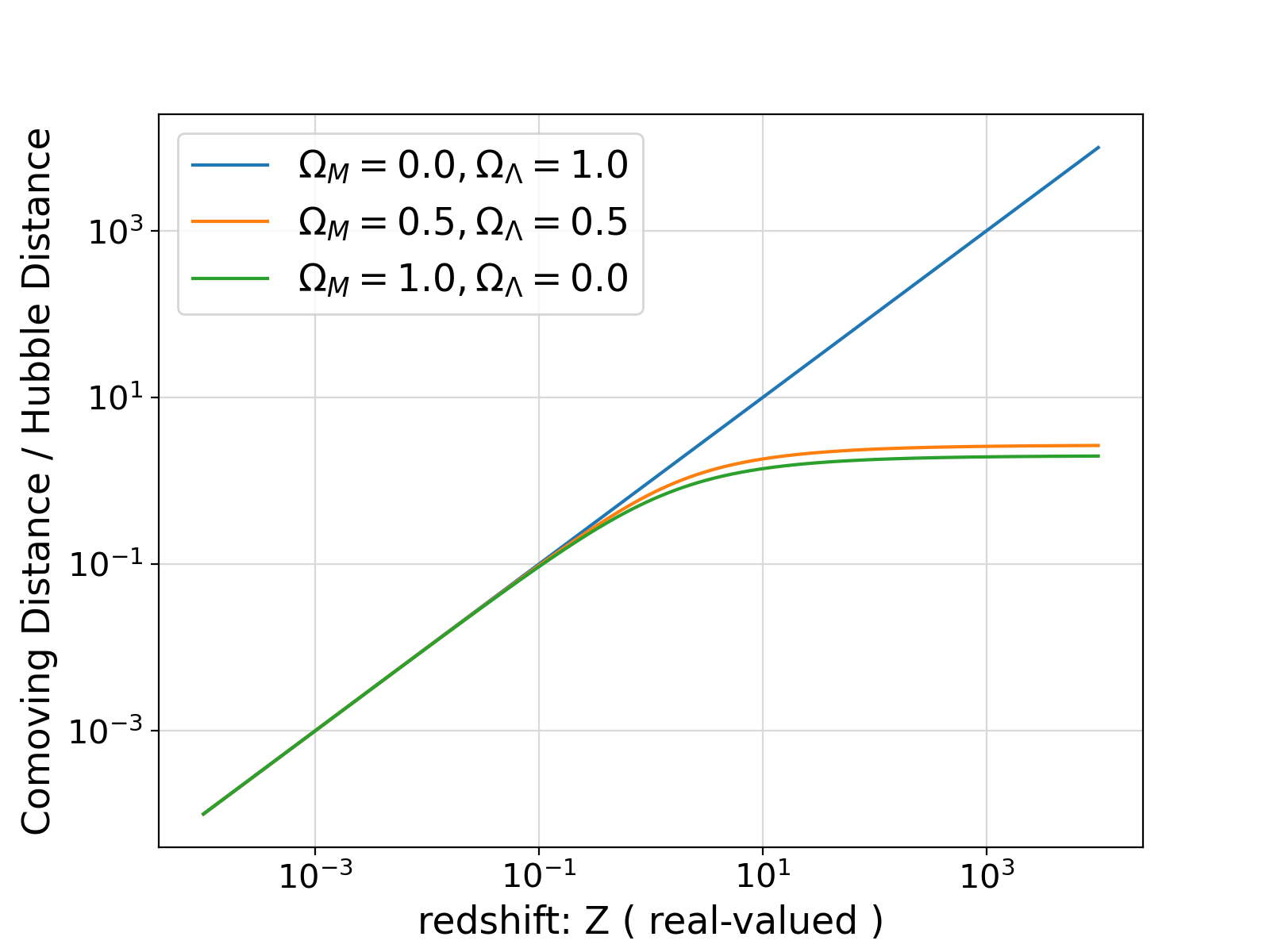
|
ParaMonte Fortran 2.0.0
Parallel Monte Carlo and Machine Learning Library
See the latest version documentation. |

|
ParaMonte Fortran 2.0.0
Parallel Monte Carlo and Machine Learning Library
See the latest version documentation. |
Generate and return the cosmological Transverse Comoving Distance normalized to Hubble Distance, given the user-specified cosmological parameters. More...
Generate and return the cosmological Transverse Comoving Distance normalized to Hubble Distance, given the user-specified cosmological parameters.
Assuming \((\Omega_M, \Omega_\Lambda, \Omega_R, \Omega_K)\) represent the normalized densities of Dark Matter, Dark Energy, Radiation Energy, and Curvature in a Universe with negligible neutrino mass such that \(\Omega_M + \Omega_\Lambda + \Omega_R + \Omega_K = 1\), the Comoving Distance between two events at the same redshift or distance but separated on the sky by some angle \(\delta\theta\) is \(D_M\delta\theta\) where \(D_M\) is the Transverse Comoving Distance and is simply related to the line-of-sight Comoving Distance as,
\begin{equation} \large D_M(z; \Omega_M, \Omega_\Lambda, \Omega_R, \Omega_K) = \begin{cases} \frac{D_H}{\sqrt{\Omega_K}} \sinh \bigg( \frac{\sqrt{\Omega_K}}{D_H} D_C \bigg) &, \Omega_K > 0 ~, \\ D_C &, \Omega_K = 0 ~, \\ \frac{D_H}{\sqrt{-\Omega_K}} \sin \bigg( \frac{\sqrt{-\Omega_K}}{D_H} D_C \bigg) &, \Omega_K < 0 ~, \end{cases} \end{equation}
where
Mpc as a function of redshift,The value returned by the procedures under this generic interface is \(\frac{D_M}{D_H}\).
The default method of computing the Transverse Comoving Distance is the same as that of the line-of-sight Comoving Distance.
| [in] | zplus1 | : The input scalar or array of the same rank as other array-like arguments, of type real of kind any supported by the processor (e.g., RK, RK32, RK64, or RK128) representing the redshift plus one, \(\log(z+1)\), at which the Comoving Distance must be computed. |
| [in] | omegaM | : The input scalar or array of the same rank as other array-like arguments, of the same type and kind as the input argument zplus1 representing the normalized matter density in the universe.(optional, default = OMEGA_M. It must be present if omegaL ( \(\Omega_\Lambda\)) is also present.) |
| [in] | omegaL | : The input scalar or array of the same rank as other array-like arguments, of the same type and kind as the input argument zplus1 representing the normalized Dark Energy density in the universe.(optional, default = OMEGA_L. It must be present if omegaR is also present.) |
| [in] | omegaR | : The input scalar or array of the same rank as other array-like arguments, of the same type and kind as the input argument zplus1 representing the normalized radiation density in the universe.(optional, default = OMEGA_R. It must be present if omegaK is also present.) |
| [in] | omegaK | : The input scalar or array of the same rank as other array-like arguments, of the same type and kind as the input argument zplus1 representing the normalized curvature density of the universe.(optional, default = OMEGA_K) |
| [in] | sqrtAbsOmegaK | : The input scalar or array of the same rank as other array-like arguments, of the same type and kind as the input argument zplus1 representing the square root of the normalized curvature density of the universe sqrt(omegaK).This argument is requested as an input to avoid the redundant costly sqrt(OmegaK) operation within the algorithm when the procedure is to be called repeatedly with the same omegaK.(optional, it must be present if and only if omegaK is also present.) |
| [in] | reltol | : See the description of the corresponding argument in the documentation of getQuadErr. A reasonable recommended value is reltol = sqrt(epsilon(real(0, kind(zplus1)))). |
| [out] | neval | : See the description of the corresponding argument in the documentation of getQuadErr. (optional. If missing, the number of function evaluations will not be returned.) |
| [out] | err | : The output scalar of type integer of default kind IK, that is set to zero if the integration converges without any errors.Otherwise, a non-zero value of err indicates the occurrence of an error of varying severities.See the description of the corresponding output argument in the documentation of getQuadErr. |
disComTransNormed : The output scalar or array of the same rank as other array-like arguments, of the same type and kind as the input argument zplus1 containing the cosmological Transverse Comoving Distance at the desired redshift normalized to the Hubble Distance.
Possible calling interfaces ⛓
CHECK_ENABLED=1.impure.elemental.omegaM = 1 and omegaL = 0 corresponds to the Einstein–de Sitter model of the universe proposed by Albert Einstein and Willem de Sitter in 1932.
Example usage ⛓
ifort compiler ⛓ ifort compiler ⛓ gfortran compiler ⛓ 
Final Remarks ⛓
If you believe this algorithm or its documentation can be improved, we appreciate your contribution and help to edit this page's documentation and source file on GitHub.
For details on the naming abbreviations, see this page.
For details on the naming conventions, see this page.
This software is distributed under the MIT license with additional terms outlined below.
This software is available to the public under a highly permissive license.
Help us justify its continued development and maintenance by acknowledging its benefit to society, distributing it, and contributing to it.
Definition at line 1523 of file pm_cosmology.F90.